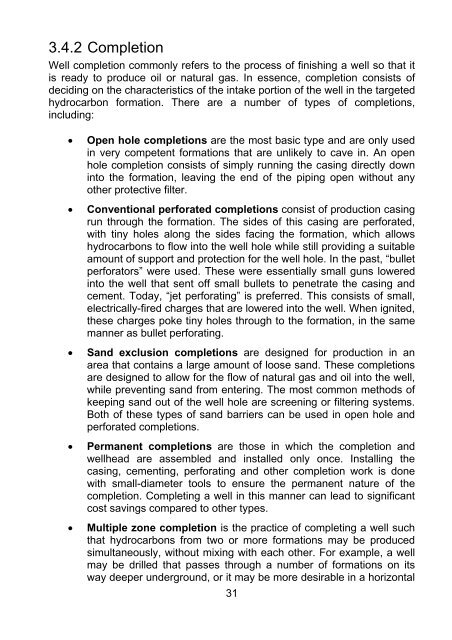Oil and gas production handbook An introduction to oil ... - ABB Group
Oil and gas production handbook An introduction to oil ... - ABB Group
Oil and gas production handbook An introduction to oil ... - ABB Group
You also want an ePaper? Increase the reach of your titles
YUMPU automatically turns print PDFs into web optimized ePapers that Google loves.
3.4.2 Completion<br />
Well completion commonly refers <strong>to</strong> the process of finishing a well so that it<br />
is ready <strong>to</strong> produce <strong>oil</strong> or natural <strong>gas</strong>. In essence, completion consists of<br />
deciding on the characteristics of the intake portion of the well in the targeted<br />
hydrocarbon formation. There are a number of types of completions,<br />
including:<br />
• Open hole completions are the most basic type <strong>and</strong> are only used<br />
in very competent formations that are unlikely <strong>to</strong> cave in. <strong>An</strong> open<br />
hole completion consists of simply running the casing directly down<br />
in<strong>to</strong> the formation, leaving the end of the piping open without any<br />
other protective filter.<br />
• Conventional perforated completions consist of <strong>production</strong> casing<br />
run through the formation. The sides of this casing are perforated,<br />
with tiny holes along the sides facing the formation, which allows<br />
hydrocarbons <strong>to</strong> flow in<strong>to</strong> the well hole while still providing a suitable<br />
amount of support <strong>and</strong> protection for the well hole. In the past, “bullet<br />
perfora<strong>to</strong>rs” were used. These were essentially small guns lowered<br />
in<strong>to</strong> the well that sent off small bullets <strong>to</strong> penetrate the casing <strong>and</strong><br />
cement. Today, “jet perforating” is preferred. This consists of small,<br />
electrically-fired charges that are lowered in<strong>to</strong> the well. When ignited,<br />
these charges poke tiny holes through <strong>to</strong> the formation, in the same<br />
manner as bullet perforating.<br />
• S<strong>and</strong> exclusion completions are designed for <strong>production</strong> in an<br />
area that contains a large amount of loose s<strong>and</strong>. These completions<br />
are designed <strong>to</strong> allow for the flow of natural <strong>gas</strong> <strong>and</strong> <strong>oil</strong> in<strong>to</strong> the well,<br />
while preventing s<strong>and</strong> from entering. The most common methods of<br />
keeping s<strong>and</strong> out of the well hole are screening or filtering systems.<br />
Both of these types of s<strong>and</strong> barriers can be used in open hole <strong>and</strong><br />
perforated completions.<br />
• Permanent completions are those in which the completion <strong>and</strong><br />
wellhead are assembled <strong>and</strong> installed only once. Installing the<br />
casing, cementing, perforating <strong>and</strong> other completion work is done<br />
with small-diameter <strong>to</strong>ols <strong>to</strong> ensure the permanent nature of the<br />
completion. Completing a well in this manner can lead <strong>to</strong> significant<br />
cost savings compared <strong>to</strong> other types.<br />
• Multiple zone completion is the practice of completing a well such<br />
that hydrocarbons from two or more formations may be produced<br />
simultaneously, without mixing with each other. For example, a well<br />
may be drilled that passes through a number of formations on its<br />
way deeper underground, or it may be more desirable in a horizontal<br />
31

















